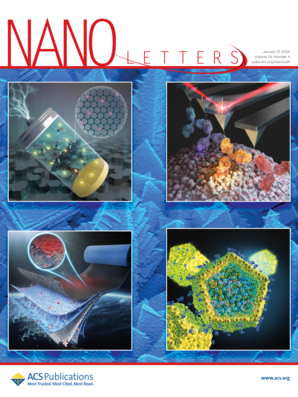Electron Cloaking in MoS2 for High-Performance Optoelectronics
IF 9.6
1区 材料科学
Q1 CHEMISTRY, MULTIDISCIPLINARY
引用次数: 0
Abstract
Defects in two-dimensional (2D) materials represent both challenges and opportunities to their optoelectronic performance. While defects limit the carrier mobility in transistors through increased charge scattering, they also enhance 2D material functionality in sensors. Electron cloaking, a process that reduces Coulomb scattering via localized electron–defect interactions, has recently been shown to mitigate the performance degradation of bulk semiconductors in the presence of defects. We demonstrate the realization of electron cloaking in 2D materials through the metal decoration of defects. Sulfur vacancies were introduced in MoS2 and selectively decorated with aluminum using atomic layer deposition. Theoretical and experimental characterization demonstrate the suppression of electronic scattering through localized interactions. Optoelectronic measurements reveal a significant improvement in carrier mobility and lifetime, highlighting the effectiveness of the cloaking mechanism. Our findings open a route independently to maximize performance and functionality of optoelectronic devices, which is illustrated by the realization photosensors with unprecedented sensitivity and speed.

用于高性能光电子学的二硫化钼的电子隐身
二维(2D)材料的缺陷对其光电性能既是挑战又是机遇。虽然缺陷通过增加电荷散射限制了晶体管中的载流子迁移率,但它们也增强了传感器中的二维材料功能。电子隐身是一种通过局域电子-缺陷相互作用减少库仑散射的工艺,最近被证明可以减轻存在缺陷的大块半导体的性能下降。我们演示了通过金属修饰缺陷在二维材料中实现电子隐身。采用原子层沉积的方法在二硫化钼中引入硫空位,并选择性地用铝进行修饰。理论和实验表征证明了通过局域相互作用抑制电子散射。光电测量显示载流子迁移率和寿命显著提高,突出了隐身机制的有效性。我们的研究结果为光电器件的性能和功能最大化开辟了一条独立的道路,这可以通过实现具有前所未有的灵敏度和速度的光传感器来说明。
本文章由计算机程序翻译,如有差异,请以英文原文为准。
求助全文
约1分钟内获得全文
求助全文
来源期刊

Nano Letters
工程技术-材料科学:综合
CiteScore
16.80
自引率
2.80%
发文量
1182
审稿时长
1.4 months
期刊介绍:
Nano Letters serves as a dynamic platform for promptly disseminating original results in fundamental, applied, and emerging research across all facets of nanoscience and nanotechnology. A pivotal criterion for inclusion within Nano Letters is the convergence of at least two different areas or disciplines, ensuring a rich interdisciplinary scope. The journal is dedicated to fostering exploration in diverse areas, including:
- Experimental and theoretical findings on physical, chemical, and biological phenomena at the nanoscale
- Synthesis, characterization, and processing of organic, inorganic, polymer, and hybrid nanomaterials through physical, chemical, and biological methodologies
- Modeling and simulation of synthetic, assembly, and interaction processes
- Realization of integrated nanostructures and nano-engineered devices exhibiting advanced performance
- Applications of nanoscale materials in living and environmental systems
Nano Letters is committed to advancing and showcasing groundbreaking research that intersects various domains, fostering innovation and collaboration in the ever-evolving field of nanoscience and nanotechnology.
 求助内容:
求助内容: 应助结果提醒方式:
应助结果提醒方式:


